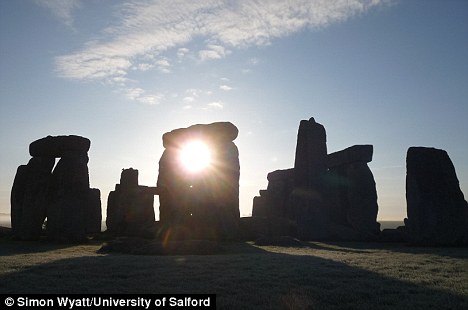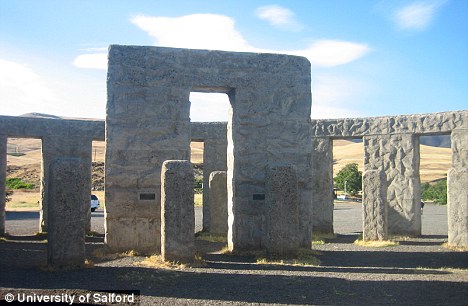
© Simon Wyatt / University of SalfordMystery: The researchers found Stonehenge reacted to acoustic activity in a way that would have been noticeable to the Neolithic man suggesting it was built with acoustics in mind
Stonehenge could have been designed with acoustics in mind like a Greek or Roman theatre, a study has revealed.
A team of researchers from the University of Salford spent four years studying the historic site's acoustic properties in a bid to crack the mystery of why it was built.
While they could not confirm the exact purpose of the stones, the researchers did find the space reacted to acoustic activity in a way that would have been noticeable to the Neolithic man.
'Stonehenge is very well known, but people are still trying to find out what it was built for and we thought that doing this research would bring an element of archaeology that so far hasn't been looked at,' lead researcher, Bruno Fazenda said.
He added the new area of acoustic science, named archaeoacoustics, could be helpful in the archaeological interpretation of important buildings and heritage sites, some of which may not exist in their original form, such as in the case of Stonehenge.
Because the site in Wiltshire is in a derelict state, researchers travelled to Maryhill in the U.S. where a full-sized concrete reconstruction of Stonehenge was built in 1929 as a memorial to the soldiers of WWI.

© University of SalfordRecreation: To get a more accurate representation, researchers travelled to Maryhill in the U.S. where a full-sized concrete reconstruction of Stonehenge was built in 1929
They were able to make proper acoustic measurements that allowed an investigation into striking acoustic effects such as echoes, resonances and whispering gallery effects.
The second phase consisted in the creation of a full 3D audio-rendition of the space using a system comprised of 64 audio channels and loudspeakers especially developed at the University of Salford based on Wave Field Synthesis.
This system enables an accurate and immersive recreation of what Stonehenge would have sounded like.
Dr Fazenda said: 'This type of research is important because now we can not only see ourselves surrounded by the stones using virtual reality, but we can also listen how the stone structure would have enveloped people in a sonic experience. It is as if we can travel back in time and experience the space in a more holistic way.'
Dr Fazenda also thinks that this research opens a whole new world for archaeoacoustics: 'Of course there are other sites of interest, and as soon as the methodology for studying acoustics in ancient spaces becomes robust then it can be used as a part of archaeology and I believe in the next ten years a lot of such studies will include acoustics.'
Now listen to recording done at Maryhill, U.S., where a concrete reconstruction of Stonehenge was built in 1929.
Full details of the project can be found
here.
A stereo rendition of a folk band singing within the Maryhill replica Stonehenge
Comment: Readers may be interested in these excerpts from the
Cassiopaean Experiment regarding Stonehenge:
Oct. 23rd 1994
Q: (L) Who built Stonehenge?
A: Druids.
Q: (L) Who were the Druids?
A: Early Aryan group.
Q: (L) How did they move the stones and set them up?
A: Sound wave focusing; try it yourself; coral castle.
Q: (L) Who taught the Druids to use the sound waves?
A: They knew; handed down.
Q: (L) When was Stonehenge built?
A: 8000 approx. BC
Q: (L) What was Stonehenge built to do or be used for?
A: Energy director.
Q: (L) What was this energy to be directed to do?
A: All things.
Q: (L) Was the energy to be directed outward or inward to the center?
A: Both.
December 8th 1996
(L) Okay, what is it about Stonehenge?
A: Location attracted those spirit types on the proper frequency, who in turn, placed stones in proper location to receive the coded communications in code telepathically, in order not to have to chase around the countryside reading encoded pictographs.
Q: (L) What was the technique used within the circle to receive the information telepathically?
A: Transcendent focused thought wave separation.
Q: (L) OK, so that you're saying that moving in a spiral...
A: The spiral serves to translate message by slowing down the wave and focusing thought wave transference energy. Utilizes /transduces electromagnetic waves, the conduit, by breaking down signal from universal language of intent into language of phonetic profile. This is for multiple user necessity.
Q: (L) Multiple user necessity implies that a number of people must do the spiral. Is that correct?
A: No. Must hear and feel and understand precisely the same thing. The molecular structure of the rock, when properly sculpted sing to you.





Comment: Readers may be interested in these excerpts from the Cassiopaean Experiment regarding Stonehenge:
Oct. 23rd 1994
Q: (L) Who built Stonehenge?
A: Druids.
Q: (L) Who were the Druids?
A: Early Aryan group.
Q: (L) How did they move the stones and set them up?
A: Sound wave focusing; try it yourself; coral castle.
Q: (L) Who taught the Druids to use the sound waves?
A: They knew; handed down.
Q: (L) When was Stonehenge built?
A: 8000 approx. BC
Q: (L) What was Stonehenge built to do or be used for?
A: Energy director.
Q: (L) What was this energy to be directed to do?
A: All things.
Q: (L) Was the energy to be directed outward or inward to the center?
A: Both.
December 8th 1996
(L) Okay, what is it about Stonehenge?
A: Location attracted those spirit types on the proper frequency, who in turn, placed stones in proper location to receive the coded communications in code telepathically, in order not to have to chase around the countryside reading encoded pictographs.
Q: (L) What was the technique used within the circle to receive the information telepathically?
A: Transcendent focused thought wave separation.
Q: (L) OK, so that you're saying that moving in a spiral...
A: The spiral serves to translate message by slowing down the wave and focusing thought wave transference energy. Utilizes /transduces electromagnetic waves, the conduit, by breaking down signal from universal language of intent into language of phonetic profile. This is for multiple user necessity.
Q: (L) Multiple user necessity implies that a number of people must do the spiral. Is that correct?
A: No. Must hear and feel and understand precisely the same thing. The molecular structure of the rock, when properly sculpted sing to you.